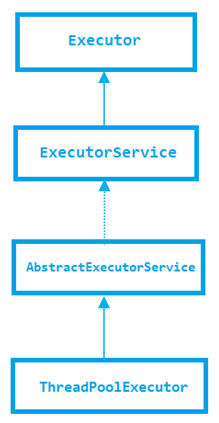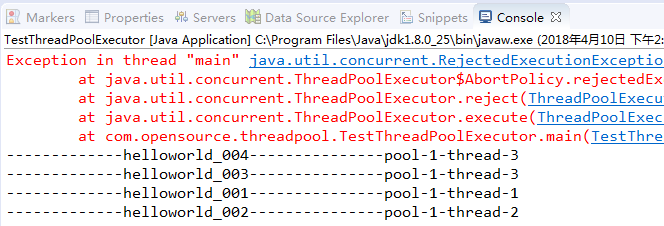为了更好的使用多线程,JDK提供了线程池供开发人员使用,目的在于减少线程的创建和销毁次数,以此达到线程的重复利用。
其中ThreadPoolExecutor是线程池中最核心的一个类,我们先简单看一下这个类的继承关系。

其中Executor是线程池的顶级接口,接口中只定义了一个方法 void execute(Runnable command);线程池的操作方法都是定义子在ExecutorService子接口中的,所以说ExecutorService是线程池真正的接口。
ThreadPoolExecutor提供了四个构造方法,我们看一下参数最全的一个构造函数;
public ThreadPoolExecutor(intcorePoolSize,intmaximumPoolSize,longkeepAliveTime,
TimeUnit unit,
BlockingQueueworkQueue,
ThreadFactory threadFactory,
RejectedExecutionHandler handler) {}
函数的参数含义如下:
corePoolSize: 线程池核心线程数
maximumPoolSize:线程池最大数
keepAliveTime: 空闲线程存活时间
unit: 时间单位
workQueue: 线程池所使用的缓冲队列
threadFactory:线程池创建线程使用的工厂
handler: 线程池对拒绝任务的处理策略
本节我们主要对前五个参数中的corePoolSize,maximumPoolSize及workQueue是如何配合使用做出说明(keepAliveTime,unit主要对空闲线程的存活时间做的定义,见名知意,不再做出说明),以此来引出线程池的一些特性。
threadFactory和handler这两个参数都有默认值,对于它们的用法将放到其它章节去做说明。
特性一:当池中正在运行的线程数(包括空闲线程)小于corePoolSize时,新建线程执行任务。
下面用实验来说明,代码如下:
public classTestThreadPoolExecutor {public static voidmain(String[] args) {
ThreadPoolExecutor pool= new ThreadPoolExecutor(2, 3, 60L, TimeUnit.SECONDS,new LinkedBlockingQueue<>(1));//任务1
pool.execute(newRunnable() {
@Overridepublic voidrun() {
System.out.println("-------------helloworld_001---------------" +Thread.currentThread().getName());
}
});try{//主线程睡2秒
Thread.sleep(2*1000);
}catch(InterruptedException e) {
e.printStackTrace();
}//任务2
pool.execute(newRunnable() {
@Overridepublic voidrun() {
System.out.println("-------------helloworld_002---------------" +Thread.currentThread().getName());
}
});
}
}
实验结果如下:

实验结果分析:
从实验结果上可以看出,当执行任务1的线程(thread-1)执行完成之后,任务2并没有去复用thread-1而是新建线程(thread-2)去执行任务。
特性二:当池中正在运行的线程数大于等于corePoolSize时,新插入的任务进入workQueue排队(如果workQueue长度允许),等待空闲线程来执行。
下面用实验来说明,代码如下:
public classTestThreadPoolExecutor {public static voidmain(String[] args) {
ThreadPoolExecutor pool= new ThreadPoolExecutor(2, 3, 60L, TimeUnit.SECONDS, new LinkedBlockingQueue<>(1));//任务1
pool.execute(newRunnable() {
@Overridepublic voidrun() {try{
Thread.sleep(3 * 1000);
System.out.println("-------------helloworld_001---------------" +Thread.currentThread().getName());
}catch(InterruptedException e) {
e.printStackTrace();
}
}
});//任务2
pool.execute(newRunnable() {
@Overridepublic voidrun() {try{
Thread.sleep(5 * 1000);
System.out.println("-------------helloworld_002---------------" +Thread.currentThread().getName());
}catch(InterruptedException e) {
e.printStackTrace();
}
}
});//任务3
pool.execute(newRunnable() {
@Overridepublic voidrun() {
System.out.println("-------------helloworld_003---------------" +Thread.currentThread().getName());
}
});
}
}
实验结果如下:

实验结果分析:
从实验结果上看,任务3会等待任务1执行完之后,有了空闲线程,才会执行。并没有新建线程执行任务3,这时maximumPoolSize=3这个参数不起作用。
特性三:当队列里的任务数达到上限,并且池中正在运行的线程数小于maximumPoolSize,对于新加入的任务,新建线程。
下面用实验来说明,代码如下:
public classTestThreadPoolExecutor {public static voidmain(String[] args) {
ThreadPoolExecutor pool= new ThreadPoolExecutor(2, 3, 60L, TimeUnit.SECONDS, new LinkedBlockingQueue<>(1));//任务1
pool.execute(newRunnable() {
@Overridepublic voidrun() {try{
Thread.sleep(3 * 1000);
System.out.println("-------------helloworld_001---------------" +Thread.currentThread().getName());
}catch(InterruptedException e) {
e.printStackTrace();
}
}
});//任务2
pool.execute(newRunnable() {
@Overridepublic voidrun() {try{
Thread.sleep(5 * 1000);
System.out.println("-------------helloworld_002---------------" +Thread.currentThread().getName());
}catch(InterruptedException e) {
e.printStackTrace();
}
}
});//任务3
pool.execute(newRunnable() {
@Overridepublic voidrun() {
System.out.println("-------------helloworld_003---------------" +Thread.currentThread().getName());
}
});//任务4
pool.execute(newRunnable() {
@Overridepublic voidrun() {
System.out.println("-------------helloworld_004---------------" +Thread.currentThread().getName());
}
});
}
}
实验结果如下:

实验结果分析:
当任务4进入队列时发现队列的长度已经到了上限,所以无法进入队列排队,而此时正在运行的线程数(2)小于maximumPoolSize所以新建线程执行该任务。
特性四:当队列里的任务数达到上限,并且池中正在运行的线程数等于maximumPoolSize,对于新加入的任务,执行拒绝策略(线程池默认的拒绝策略是抛异常)。
下面用实验来说明,代码如下:
public classTestThreadPoolExecutor {public static voidmain(String[] args) {
ThreadPoolExecutor pool= new ThreadPoolExecutor(2, 3, 60L, TimeUnit.SECONDS, new LinkedBlockingQueue<>(1));//任务1
pool.execute(newRunnable() {
@Overridepublic voidrun() {try{
Thread.sleep(3 * 1000);
System.out.println("-------------helloworld_001---------------" +Thread.currentThread().getName());
}catch(InterruptedException e) {
e.printStackTrace();
}
}
});//任务2
pool.execute(newRunnable() {
@Overridepublic voidrun() {try{
Thread.sleep(5 * 1000);
System.out.println("-------------helloworld_002---------------" +Thread.currentThread().getName());
}catch(InterruptedException e) {
e.printStackTrace();
}
}
});//任务3
pool.execute(newRunnable() {
@Overridepublic voidrun() {
System.out.println("-------------helloworld_003---------------" +Thread.currentThread().getName());
}
});//任务4
pool.execute(newRunnable() {
@Overridepublic voidrun() {try{
Thread.sleep(2 * 1000);
}catch(InterruptedException e) {
e.printStackTrace();
}
System.out.println("-------------helloworld_004---------------" +Thread.currentThread().getName());
}
});//任务5
pool.execute(newRunnable() {
@Overridepublic voidrun() {
System.out.println("-------------helloworld_005---------------" +Thread.currentThread().getName());
}
});
}
}
实验结果如下:

实验结果分析:
当任务5加入时,队列达到上限,池内运行的线程数达到最大,故执行默认的拒绝策略,抛异常。
本文中使用到的队列类型虽然仅限于LinkedBlockingQueue这一种队列类型,但总结出来的特性,对与常用ArrayBlockingQueue 和 SynchronousQueue同样适用,些许不同及三种队列的区别,将在下个章节中说明。
最后说一点,我们作为程序员,研究问题还是要仔细深入一点的。当你对原理了解的有够透彻,开发起来也就得心应手了,很多开发中的问题和疑惑也就迎刃而解了,而且在面对其他问题的时候也可做到触类旁通。当然在开发中没有太多的时间让你去研究原理,开发中要以实现功能为前提,可等项目上线的后,你有大把的时间或者空余的时间,你大可去刨根问底,深入的去研究一项技术,为觉得这对一名程序员的成长是很重要的事情。





















 2837
2837











 被折叠的 条评论
为什么被折叠?
被折叠的 条评论
为什么被折叠?








